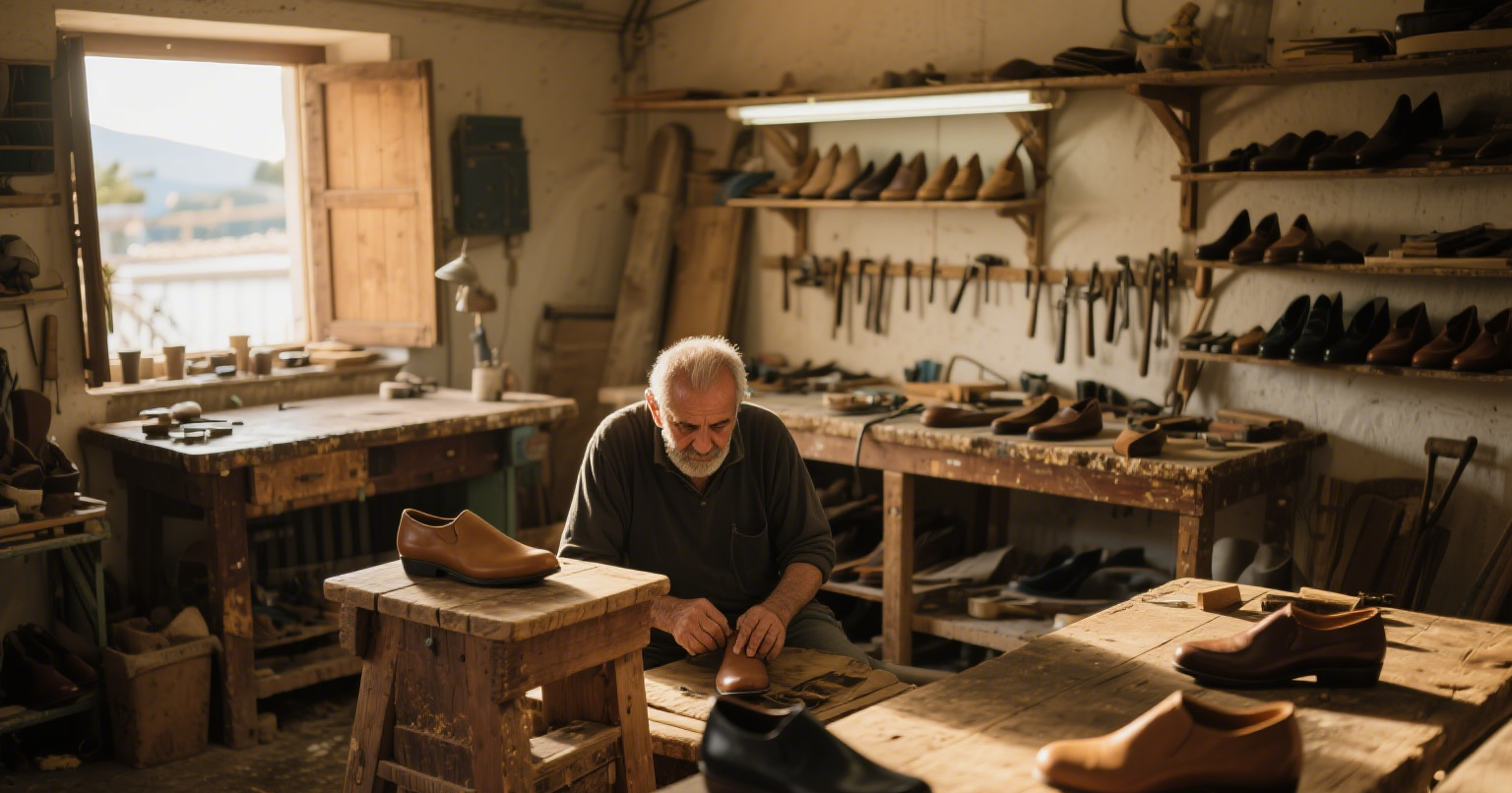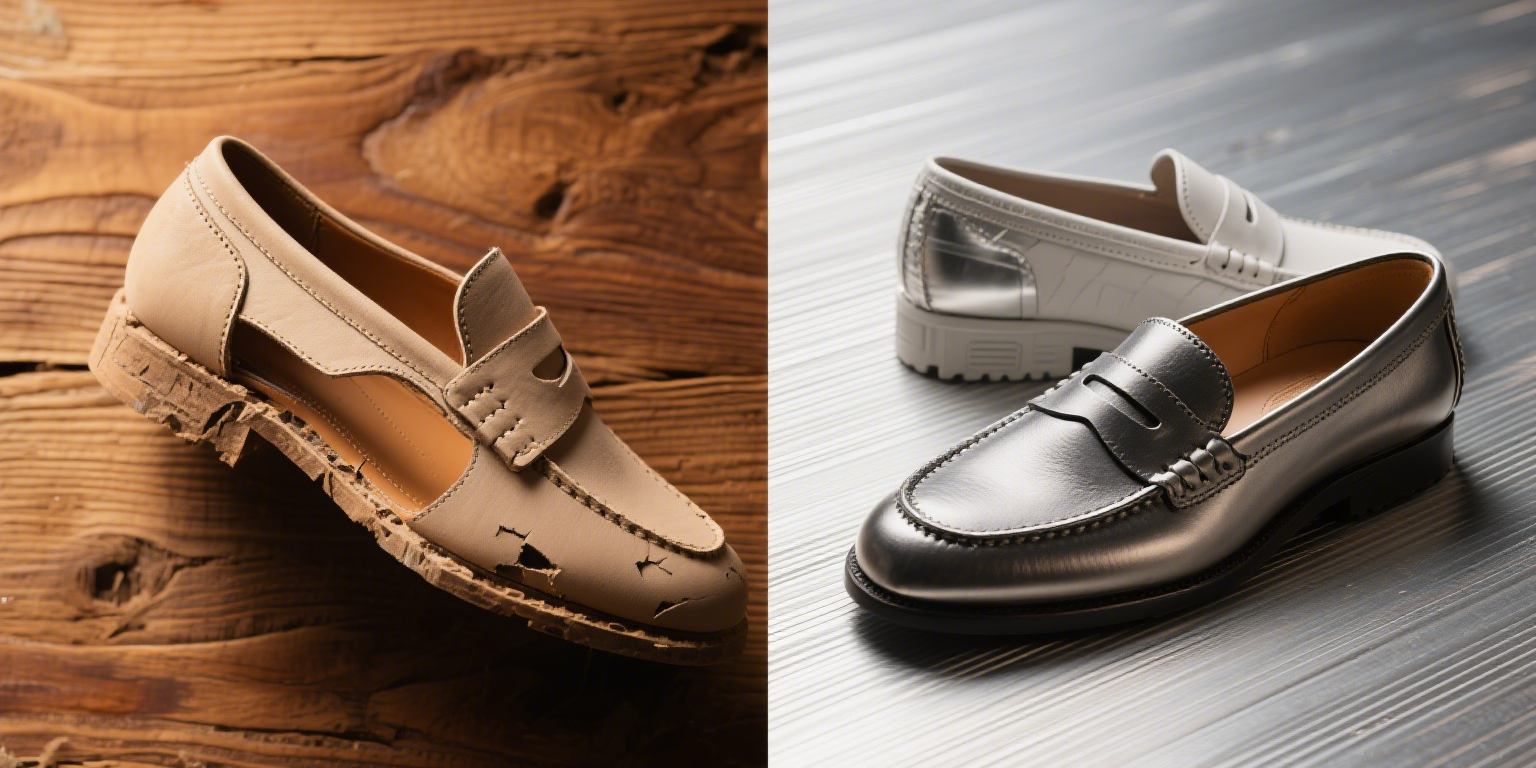Are you curious why more luxury brands are shifting their shoe production to places like Italy and Portugal, even when Asian manufacturing still dominates in volume? It's about more than just cost. Luxury brands are increasingly moving shoe production to Italy and Portugal due to their unparalleled reputation for artisanal craftsmanship, specialized technical expertise, access to high-quality materials, flexible production capabilities for smaller batches, and adherence to European labor and environmental standards. These factors collectively ensure the superior quality, ethical production, and brand prestige that luxury consumers expect, contrasting with the high-volume, mass-production model often found in Asia.
What makes Italian and Portuguese shoe craftsmanship special?
Are you wondering what elevates Italian and Portuguese shoe craftsmanship to such a revered status in the global footwear industry? It's a combination of tradition, skill, and specialization.
Italian and Portuguese shoe craftsmanship is special due to a deep-rooted heritage of artisanal techniques passed down through generations, highly skilled and specialized labor, meticulous attention to detail at every stage of production, sophisticated knowledge of diverse, high-quality materials, and a commitment to producing footwear with superior comfort, durability, and aesthetic appeal. These regions boast mature clusters of specialized factories, material suppliers, and technical experts dedicated solely to shoemaking.
 At Lucas, while we pride ourselves on efficient, quality manufacturing, we recognize and admire the generations of specialized skill that define Italian and Portuguese shoemaking. It's a different approach, steeped in specific traditions.
At Lucas, while we pride ourselves on efficient, quality manufacturing, we recognize and admire the generations of specialized skill that define Italian and Portuguese shoemaking. It's a different approach, steeped in specific traditions.
The Distinctive Hallmarks of Italian and Portuguese Shoemaking
The reputation of Italian and Portuguese shoe craftsmanship is built upon a foundation of unique characteristics that distinguish their production methods and final products.
- 1. Generations of Artisanal Heritage and Knowledge Transfer:
- In both Italy (e.g., Marche, Tuscany, Campania regions) and Portugal (especially in the Felgueiras, Guimarães, Santa Maria da Feira area), shoemaking is not just an industry; it's a deeply ingrained tradition. Skills and knowledge, including intricate hand-stitching, advanced pattern making, and specialized construction techniques (like Blake stitching, Goodyear welting), are passed down from master craftsmen to apprentices over generations within families and specialized workshops. This creates a highly skilled workforce with an innate understanding of materials and shoe construction.
- 2. Meticulous Attention to Detail:
- Craftsmen in these regions are known for their fastidious approach to every stage of production. From the precise cutting of leather to the perfect alignment of seams and the final finishing touches, every step is executed with extreme care. This detail-oriented approach ensures a high level of aesthetic perfection and structural integrity in the finished product.
- 3. Access to High-Quality Materials and Components:
- Italy, in particular, is a global leader in leather tanning, producing some of the finest hides in the world. Both countries have robust ancillary industries providing high-quality components like soles, heels, lasts, and specialized finishing products. Proximity to these superior material suppliers means that manufacturers don't compromise on input quality, leading to a better final product.
- 4. Specialized Expertise in Complex Constructions:
- These regions excel in a variety of complex shoe constructions that offer superior comfort, durability, and flexibility. For instance, Goodyear welting, a time-consuming but highly durable construction method, is a specialty in some Italian and Portuguese workshops. This technical expertise allows for the creation of intricate and high-performance footwear.
- 5. Flexibility and Boutique Production Capabilities:
- Unlike large-scale mass production facilities, many Italian and Portuguese factories are mid-sized or smaller, family-run businesses. This allows for greater flexibility in production, enabling them to handle smaller, more customized orders, adapt quickly to changes in design, and offer bespoke solutions – ideal for luxury brands that often produce limited collections.
- 6. Design Innovation and Fashion Acumen:
- Both countries are at the forefront of fashion trends. Italian and Portuguese shoe manufacturers are not just skilled craftsmen; they also possess a keen understanding of global fashion aesthetics and design innovation. This combination of technical skill and design sensibility ensures that their shoes are not only well-made but also stylish and contemporary.
This unique combination of heritage, skill, quality materials, and flexibility makes Italian and Portuguese shoemaking a desirable choice for luxury brands seeking to uphold their reputation for excellence.
| Aspect | Description of Italian/Portuguese Specialization |
|---|---|
| Artisanal Heritage | Multi-generational skill transfer, deep traditional knowledge. |
| Attention to Detail | Meticulous execution at every production stage. |
| High-Quality Materials | Proximity to top-tier leather tanneries and component suppliers. |
| Specialized Expertise | Mastery of complex constructions (e.g., Goodyear welting). |
| Production Flexibility | Ability to handle smaller, customized batches for luxury. |
| Design Innovation | Strong understanding of fashion trends, blending style with craft. |
Are Italian shoes better quality than Asian-made shoes?
Are you questioning whether a shoe made in Italy inherently means higher quality than one manufactured in Asia? It's a common perception, but the reality is more nuanced than a simple yes or no.
Italian-made shoes often signify superior quality due to factors like their heritage of artisanal craftsmanship, use of premium materials, focus on intricate traditional construction methods, and strong design capabilities. However, Asian-made shoes, particularly from countries like China, can also achieve very high quality standards, especially when produced by factories with advanced technology, stringent quality control systems, and specific brand requirements, though they typically excel in efficiency and scale rather than traditional handcraftsmanship. The quality largely depends on the factory, the materials specified, and the brand's quality control.
 As the founder of Lucas, a manufacturer of quality shoes in China, I can confidently say that "Asian-made" does not automatically mean lower quality. We produce shoes that meet rigorous global standards. It's about the client's specifications and the factory's commitment, not solely the country of origin.
As the founder of Lucas, a manufacturer of quality shoes in China, I can confidently say that "Asian-made" does not automatically mean lower quality. We produce shoes that meet rigorous global standards. It's about the client's specifications and the factory's commitment, not solely the country of origin.
The Nuance of Quality: Origin vs. Specification
The perception that Italian shoes are universally "better" than Asian-made shoes is largely a generalization that doesn't account for the diversity and capabilities within both regions.
- Strengths of Italian Shoes (typically for Luxury/High-End):
- Craftsmanship and Handwork: Italian shoemaking emphasizes traditional techniques, often involving significant hand-stitching, hand-finishing, and attention to subtle details that contribute to the shoe's aesthetic and longevity. This often results in a distinct "feel" and appearance.
- Premium Materials: Italian manufacturers frequently use top-grade leathers, meticulously tanned to showcase their natural beauty and durability. The entire supply chain is geared towards luxury inputs.
- Design and Aesthetic Vision: Italy is a global fashion hub, and its shoemakers are deeply connected to design trends, ensuring shoes are not just well-made but also fashion-forward and aesthetically refined.
- Smaller Batch Production: Many Italian factories are adept at producing smaller, more exclusive collections, allowing for greater attention to each pair.
- Capabilities of Asian-Made Shoes (especially from China):
- Scale and Efficiency: Countries like China excel in mass production, offering unparalleled capacity and cost-effectiveness for large orders. This doesn't inherently mean low quality, but it means their process is optimized for volume. At Lucas, our strength lies in handling large, diverse orders efficiently.
- Technological Advancement: Many top-tier Asian factories have invested heavily in advanced machinery, automation, and robotic processes. This technology allows for extreme precision, consistency, and a high level of quality control, especially for technical footwear (e.g., athletic shoes).
- Versatility: Asian factories produce the entire spectrum of footwear, from entry-level fashion to highly technical performance shoes and even luxury-grade products when specified by brands. The quality varies based on the brand's target price point and exact specifications for materials and construction.
- Cost-Effectiveness for High Volumes: When a brand specifies high-quality materials and demands stringent quality control, many Asian factories can deliver excellent products at a more competitive price point for volume orders due to their efficient infrastructure and supply chain.
- Brand Specifications Drive Quality: The quality of an "Asian-made" shoe is ultimately dictated by the brand commissioning it. If a luxury brand provides premium materials, demands high standards, and implements continuous quality checks, the Asian factory can produce shoes of exceptional quality. The difference might be in the extent of handcraftsmanship versus machine precision.
Therefore, the statement "Italian shoes are better quality" should be interpreted as "Italian shoes, especially luxury ones, are known for a specific type of artisanal quality, premium materials, and design finesse." High-quality shoes can absolutely be made in Asia when the brand's specifications, material choices, and the factory's commitment align with demanding quality standards. It's not about the continent; it's about the conscious choices made at every step of the supply chain and manufacturing process.
| Quality Aspect | Italian-Made (Typical for Luxury) | Asian-Made (Variety of Qualities Possible) |
|---|---|---|
| Craftsmanship Focus | High emphasis on handwork, traditional techniques, artistry. | Can be highly automated/machine-precise; handwork varies by spec. |
| Material Sourcing | Often premium, locally sourced (e.g., fine Italian leather). | Varies from low-cost synthetics to highly specified premium inputs. |
| Design Orientation | Strong focus on fashion trends, aesthetic refinement. | Capable of producing diverse styles; quality driven by client design. |
| Production Volume | Typically smaller batches, more customized production. | Excels in large-scale, high-volume production. |
| Cost Efficiency for Quality | Higher per-unit cost due to artisanal labor, premium materials. | Can achieve high quality at more competitive prices for volume. |
| Quality Control | Integrated into artisanal process; brand specification driven. | Relies on advanced QMS, technology, and brand oversight. |
How do costs compare between European and Asian shoe factories? Are you examining the economic differences in footwear manufacturing between European and Asian factories? The cost structures are distinct and reflect different strategic advantages. Costs are significantly higher in European shoe factories (like Italy and Portugal) primarily due to higher labor wages, greater investment in traditional craftsmanship, and the use of premium, often locally sourced, materials. In contrast, Asian shoe factories (like China and Vietnam) typically offer lower overall production costs due to more competitive labor rates, economies of scale, vast and efficient supply chains for materials, and heavy investment in automation for high-volume manufacturing. The choice between them often balances unit cost against factors like craftsmanship, flexibility, and brand story. At Lucas, headquartered in China, we understand precisely how our cost structure allows us to offer competitive pricing for high volumes, a distinct advantage over many European operations, particularly when the end product doesn't require extensive handcraftsmanship.
Cost Structures in European vs. Asian Shoe Manufacturing
The cost comparison between European and Asian shoe factories reveals why brands choose one over the other based on their product type, target market, and brand values.
- 1. Labor Costs:
- Europe (Italy, Portugal): Wages are considerably higher due to higher living standards, stronger labor protections (e.g., minimum wage, benefits), and the premium associated with skilled artisanal labor. This is a primary driver of higher unit costs.
- Asia (China, Vietnam): While wages have risen, they generally remain more competitive compared to Europe. Labor laws are often less stringent, and automation helps offset rising labor costs, especially for high-volume production.
- 2. Material Costs:
- Europe: Often utilizes higher-priced, premium materials (e.g., Italian tanneries' leather, specialized components). Brands producing in Europe tend to specify top-tier inputs to match the craftsmanship.
- Asia: Has access to a vast global supply chain, allowing for a wider range of material qualities and price points. While premium materials are available, there's also an extensive network for more cost-effective options, enabling flexibility across various price segments.
- 3. Production Volume and Economies of Scale:
- Europe: Many factories are traditional, smaller, or mid-sized, focusing on quality and flexibility for smaller batches. This means fixed costs are spread over fewer units, leading to higher per-unit costs.
- Asia: Optimized for massive production volumes. Larger orders allow for significant economies of scale, reducing the per-unit cost for materials, labor allocation, and overhead.
- 4. Technology and Automation Investment:
- Europe: While integrating modern tech, many European factories still heavily rely on manual craftsmanship for luxury items, which is labor-intensive.
- Asia: Particularly China, has invested heavily in advanced automation, robotics, and smart manufacturing. This reduces dependence on manual labor and increases efficiency, driving down costs per unit at high volumes.
- 5. Research, Development, and Design:
- Europe: Investment in original design and R&D for innovative constructions is factored into the cost, as many European factories also serve as design partners for brands.
- Asia: Can execute designs provided by brands with high efficiency, reducing the R&D cost that needs to be absorbed by the manufacturer, or offer ODM (Original Design Manufacturer) services where their R&D costs are absorbed into larger volume contracts.
- 6. Overhead and Operational Costs:
- Europe: Utilities, rent, and general operational expenses are often higher in European countries.
- Asia: While also on the rise, general overhead and infrastructure costs can be more competitive, especially in industrial clusters.
The cost advantage of Asian factories is significant for brands seeking high volume at competitive prices, particularly for mass-market or mid-range products. European factories command a premium for their specialized craftsmanship, premium materials, and flexible, often smaller-scale, production for luxury and high-end niche products. As Lucas, we bridge this gap by offering high quality at Chinese production prices.
| Cost Factor | European Factories (Italy, Portugal) | Asian Factories (e.g., China, Vietnam) |
|---|---|---|
| Labor Wages | Significantly higher due to living standards, skilled labor premium. | More competitive; rising but offset by automation, scale. |
| Material Quality/Cost | Focus on premium, often locally sourced, higher-priced materials. | Access to vast range of qualities/prices; competitive bulk sourcing. |
| Production Volume | Lower, flexible batch sizes; higher per-unit overhead. | Capable of massive volumes; significant economies of scale. |
| Automation Investment | Varies; often balanced with skilled manual work. | Heavy investment in cutting-edge automation for efficiency. |
| R&D/Design Contribution | Higher contribution to original design and innovative construction. | Primarily execution of client designs; can offer ODM at scale. |
| Overhead/Operations | Generally higher utility, rent, and operational expenses. | More competitive operational costs, especially in industrial clusters. |
Conclusion Luxury brands favor Italy and Portugal for shoe production due to unparalleled artisanal craftsmanship, premium materials, and flexible, smaller-batch capabilities, ensuring superior quality and brand prestige. While Asian factories are highly capable of producing great quality at scale with advanced technology, the cost comparison heavily favors Asia due to lower labor rates and significant economies of scale, making Europe the clear choice for specific luxury values and bespoke production.
